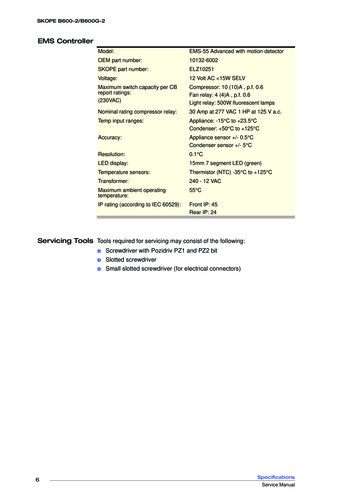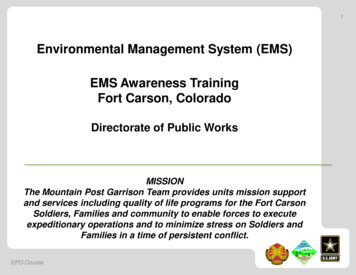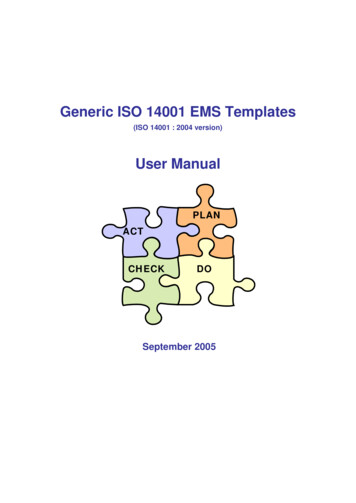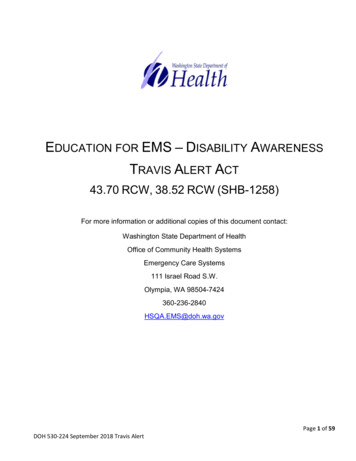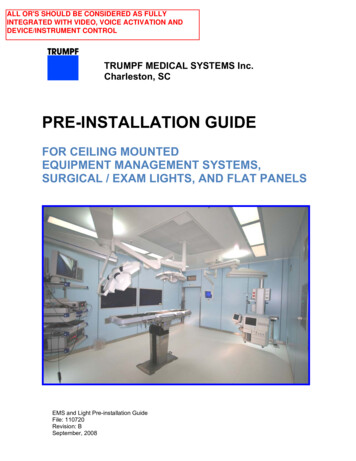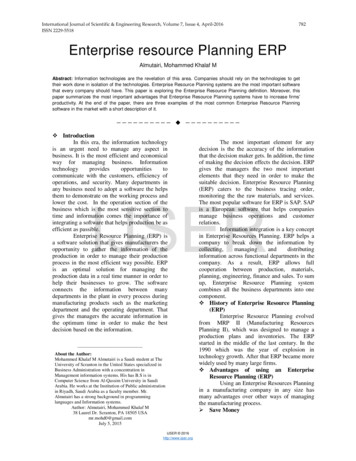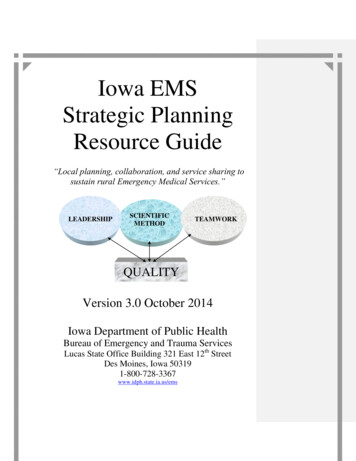
Transcription
Iowa EMSStrategic PlanningResource Guide“Local planning, collaboration, and service sharing tosustain rural Emergency Medical ITYVersion 3.0 October 2014Iowa Department of Public HealthBureau of Emergency and Trauma ServicesLucas State Office Building 321 East 12th StreetDes Moines, Iowa 503191-800-728-3367www.idph.state.ia.us/ems
EMS Strategic Planning Guide/CourseOverview:The Iowa Department of Public Health Bureau of Emergency and Trauma Servicesrecognizes the unique challenges associated with the delivery of volunteer EMS. Theaverage volunteer remains active less than 5 years. Although most volunteers have acaring attitude and a deep commitment to community service, they are often unpreparedfor the stresses they will encounter. They may frequently be asked to make patient caredecisions that the training and their experience may not prepare them for. Limitedsupervision and inadequate medical direction contribute to the high turnover rate. A1990 National Rural Health Association study of rural EMS identified the followingcommon characteristics among successful EMS systems: Integration of sound business practices into the volunteer organization Commitment to strategic planning Admission criteria for volunteer members Participation and commitment of community leaders High visibility of service A formal organizational structure Cohesive community environment Strong physician involvement Good interagency relationshipsPurpose:The Iowa EMS Strategic Planning Guide and Course were developed in 2004 to inspirelocal planning, collaboration and service sharing to build strong EMS systems.This guide is to be used in conjunction with the Iowa EMS Strategic Planning Course andthe Iowa EMS Continuous Quality Improvement Course offered by Bureau ofEmergency and Trauma Services staff. The State EMS Physician Medical Director isalso available for consultation with local physicians.Mission:The Iowa EMS Strategic Planning Guide/Course is designed to share basic strategicplanning information with communities wishing to build healthy and sustainable EMSsystems that are fully integrated into the overall health care system.Vision:Iowa EMS providers will work with all stakeholders to consistently utilize basic strategicplanning principles to build and sustain effective EMS systems.The Iowa EMS Strategic Planning Guide and Course will continue to be monitored foreffectiveness. As additional system needs become apparent, these tools will be enhancedand modified to meet the challenges of building sustainable EMS systems in Iowa.2 of 43October 2014
TABLE OF CONTENTSDESCRIPTIONPAGE NUMBERDocument Overview, Purpose, Mission, and Vision-----------------2PART I: OVERVIEW AND ORGANIZATIONAL ASPECTSThe Challenge for Iowa ------5EMS System -------------------6Strategic Planning -------------7EMS System Coordinator ----8EMS Advisory Council ---9EMS Advisory Council Function and Activities-----------------------------10Group ------------------------11Recommended Publications and Websites------------------------------------12PART II: PLANNINGAdvisory Council Mission, Vision, Values, and Guiding Principles-----14Medical Director Recommendations for the EMS System------------15-16Short Term -------------------17Long Term -------------------18Goal -------------------------19EMS Service Program Strategic Quality Planning---------------------20-21EMS System Assessment -24PART III: SAMPLE DOCUMENTSAdvisory Council Agenda for Initial Meeting-------------------------------26Advisory Council Member Function and Roster------------------------27-28Advisory Council Agenda for Subsequent Meetings-----------------------29Advisory Council ------30-31Advisory Council -----32-35EMS Coordinator Job ----36EMS Coordinator Job 7-39EMS Coordinator Job -40-433 of 43October 2014
Iowa EMS Strategic Planning GuidePART I:OVERVIEW ANDORGANIZATIONAL ASPECTS4 of 43October 2014
The Challenge for Iowa EMSThrough intensive study of rural fire and EMS in 1996, the Iowa Fire Institute identified thefollowing universal problems that seem to effect most rural EMS services in Iowa. Decreasing volunteer pool.Difficult recruitment and retention of certified personnel.Lack of weekday coverage.Escalating vehicle, equipment, and training costs.Increasing administrative demands.Stagnant or decreasing budgets require more volunteer fund raising activities.Escalating demands on personal time.Increasing government regulations and un-funded mandates.Hazardous materials response regulations.Difficult reimbursement from Medicare, Medicaid, and insurance companies.Personal liability and safety issues.Hospital staff RN’s utilized for facility-to-facility transfers.Increasing non-emergency transportation requests.Delivery of health care services is in a rapid state of change, and delivery of care in the out-ofhospital setting by EMS providers is no exception. Volunteerism is no longer able to sustain afull-time transporting ambulance service in every community, and advancing technology andincreasing national standards for training and certification is increasing the standard of patientcare. Systems of care need to be built on collaborative partnerships among existing EMS serviceprograms and are essential for the survival of EMS, especially in rural areas of Iowa. Severalmodels of excellence already exist in Iowa and typically involve maintaining advanced care at thecommunity level via a non-transport service program then tiering with a county or regionaltransport system. It is medically sound and fiscally prudent to design and implement a tieredresponse system using a non-transport level of care locally with simultaneous dispatch of anambulance. Using this system design, local communities are able to provide essential life-savinginterventions (defibrillation for cardiac arrest and advanced airway management) in addition toroutine basic care provided for all injury and/or illness events. This is achieved at a much lowercost and with lessened requirements for personnel and service program certification. Change, assuch, is often difficult to accept and implement on a local level and therefore requirescollaborative strategic planning initiatives.The net gain of EMS systems development for Iowans is improved access to more efficient andeffective emergency medical services when needed. Such endeavors have a great potential toreduce suffering, disability, death, and costs associated with injury and illness.Each EMS system development project must focus on: injury and illness prevention, timely access for all Iowans for care of life threatening illness and injury, and cost effective EMS system development and maintenance.The challenge for today’s EMS is to create collaborative partnerships of all stakeholders toengage in vigorous strategic planning to build tomorrow’s EMS. Together we can build asustainable public safety net that is integrated into the existing health care system.5 of 43October 2014
EMS System DesignThis basic system design provides consistent, on-going oversight. The most successfulEMS systems conserve human resources by having one physician provide system medicaloversight for all service programs. The EMS System Coordinator works to reduce theadministrative burden on the volunteer EMS provider.EMS Physician Responsibilities:By law, the EMS system physician medical director shall be responsible for providing appropriatemedical direction and overall supervision of the medical aspects of the EMS system. Asminimum, physician duties include liaison to the medical community, protocol development,medical auditing, and skill maintenance. Iowa Administrative Code allows the physician toappoint assistants to accomplish tasks.EMS System Coordinator Responsibilities:The EMS Coordinator manages the daily activities and implements the physician orders and EMSTask Force desires throughout the system. The coordinator acts as the link between the EMSproviders and the system physician medical director.Central Administration:The EMS System Coordinator assists the physician, providers, and consumers by developing andimplementing system policies and procedures in the following areas:CredentialingPersonnel rosters and filesSkill maintenance (competency)Education filesCommon protocolsEquipment maintenancePharmacyInitial and CEH education planMedical auditingLiaison to local government bodiesBilling and collectionsRegulatory liaisonData collectionFundraisingBulk purchasingHealth promotionPublic Information and EducationIndividual Service Programs Implement:Credentialing procedureSkill maintenance procedureAppropriate staffing schedulesPeriodic vehicle/equipment checklistsLocal policies and proceduresEquipment maintenance (defib, suction, etc.)EMS System Task Force:Strategic planningPublic Information and EducationHealth promotion activitiesTIERED RESPONSE SYSTEM:Tiered response is the centrally located career ambulance service integrated with volunteer non-transportteams and simultaneous dispatching. The design is intended to reduce the burden on the volunteer EMSprovider, produce consistent medical oversight, and decrease the fiscal load. System emphasis is onreduction of duplication of services and equipment.The definition of insanity is continuing to do the same things and expecting different results. Thinksmarter, not harder.” Gerald Nadler6 of 43October 2014
Strategic Planning Process1.2.3.4.Select Task Force Members.a.Select group leaderb.Select recorderCreate Mission, Vision, Values, and Guiding Principals.Develop by-laws and rules of order.Acquire a full system assessment and report. www.citmt.org or pages“Make decisions based on facts and data rather than emotion and perceptions.”a.Decide what do you want to knowb.Collect informationc.Compile reportPLAN:Develop a System Strategic Plan.a.System physician and medical community establish minimum medicalperformance standards (see pages 14 and 15)b.Establish system indicators to measure operationsc.Establish system indicators to measure administrationSet system goals and timeline.a.Prioritize short and long term goals (see pages 17-19)b.Establish timeline for goal implementationIndividual EMS Service Programs may wish to establish local Strategic Quality PlanningGoals (see pages 20-21)DO:Implement improvement actions.a.Document current performanceb.Measure extent of the problemc.Measure causes and frequency of the problemd.Establish clinical indicators to measure system medical performance.e.Routinely compile dataCHECK:Measure benefits of improvement actions.a.Analyze dataACT:Make decisions and implement changes, if needed, based on relevant information.a.If expected benefits were achieved, standardize the changes.b.If expected benefits were not achieved, revisit the process analysis stage.Use the PLAN-DO-CHECK-ACT model for all challenges. This is an ongoing processthat continually monitors the system structure, process, and outcomes.“HOW we do things is as important, or possiblyeven more important than WHAT we do.” George Whetsell7
EMS System Coordinator DutiesThe Coordinator is the backbone of EMS system. The coordinator functions toimplement the wishes of EMS Advisory Council and EMS Physician Medical Director.Management of EMS system day-to-day operations reduces the burden on the volunteerEMS provider and strengthens the system.Liaison to:EMS physician medical directorGovernment agenciesHospitalIowa EMS AssociationDispatch centerEMS training programMediaLeads EMS Task ForceImplements the wishes of the Task ForceSystem policy and procedure development and implementationSystem CQIMedical record auditsMonitors clinical indicatorsTraining/CEH/skill maintenanceCredentialingEducation plan and filesVehicle and equipment maintenanceEquipment placement and replacementBilling and collectionsData collection and reportingPersonnel utilization, recruitment, and retentionHealth promotion activities (primary and secondary)Chain of Survival-cardiac/strokePrevention, emergency recognition, EMS system accessCPR and early defibrillation programs (PAD)Child Passenger Safety Seat InspectionsBicycle RodeoWater safetyEMS Week activitiesPriorities based on local dataThe definition of insanity is continuing to do the same things and expectingdifferent results. Think smarter, not harder.” Gerald Nadler8
EMS Advisory Council MembershipEMS Advisory Council membership is based on equal representation of stakeholders.The suggested number of representatives is variable based on local needs and resources.It is important to limit the number of representatives for each category to allow thecommittee to work efficiently. Each representative is responsible to the organization theyrepresent for education and consensus building. It is quite possible that some delegatesmay represent more than one agency. For example, the Sheriff often represents the 911board and dispatch center.All stakeholders must understand and commit to the ongoing strategic planning processthat will maintain the system, assure quality, measure effectiveness, and efficiency. Inthe beginning, committee work can be quite time consuming. Once the foundation is builtand processes are in place, the EMS Advisory Council will probably meet only once ortwice a year. Emerging issues are often dealt with in empowered subcommittees.The Advisory Council can rely on the Iowa Department of Public Health and IowaDepartment of Economic Development as well as local Councils of Government fortechnical assistance.These representatives must strongly support and champion the vision, mission, and goalsthe EMS Advisory Council creates.SUGGESTED EMS ADVISORY COUNCIL MEMBERSHIPPhysician Medical DirectorLaw Enforcement AgenciesCounty EMS Association ChairDispatch AgencyCounty Emergency ManagementCounty Board of SupervisorsEMS ProvidersCounty Public HealthHospital AdministrationCity GovernmentEmergency Room Department HeadTownship TrusteesEmergency Room Staff RNEMS Training Program ManagerFire AgenciesLocal EMS InstructorThe suggested EMS Advisory Council Membership list represents key stakeholders and mayneed to be expanded bases upon the dynamics of local constituency.“The best idea is the sum ofcomponents of many ideas expressedin the group.”9
EMS Advisory Council Function andGeneral ActivitiesFunction Ensure access and quality by evaluating the structure, process, and outcome of EMS events.Fiscally ResponsibleAppropriate resource utilizationReduce the burden on the volunteer EMS providerIntegrate EMS into the existing healthcare systemOn-going system strategic planning, implementation, and monitoring. Gather and analyze EMS system information and dataMake decisions based on factsAcquire an EMS system coordinatorSet and implement goalsContinually monitor system structure, process, and outcomes.General ActivitiesOften sub-committees are formed for detailed work to study emerging issues and bringsuggestions for implementation back to the entire task force. Sub-committees cannot actindependently as there is often overlap in tasks. For example, the medical performancecommittee is charged with setting minimum response time and level, but the fiscal committeewill determine if the system can support the suggestions.Medical Performance Standards: On and off-line medical direction Minimum response Protocols System CQI Credentialing/competency Documentation/Data Input Risk managementFiscal Management Accountability Based on performance standards Grant opportunities Equitable cost sharing Eliminate duplication and waste Allows for system growthHealth Promotion (primary andsecondary) Injury and illness prevention Public information and educationHuman Resources Leadership Education and training Recruitment and retention Tiered response Non-transport or ambulance“Flexible, creative thinking leads tobetter solutions which leads to quality.”10
Group DynamicsGROUND RULES:ListenBe honestBe on timeBe preparedKeep to the issueRespect othersIt’s okay to disagreeEveryone participatesCritique ideas not peopleTeam decisions by consensusAll ideas are respected and valuedKeep others you represent informedShare concerns, feedback, and feelingsAVOID THESE NEGATIVE BEHAVIORS:Not allowing sufficient time for closureCompeting directly with another personMaintaining a self-limiting perspectiveFailing to get closure on an ideaCensoring one’s own ideasTelling lengthy war storiesIgnoring ideas altogetherPushing a hidden agendaCovertly rejecting ideasOvertly rejecting ideasNo side conversationsGoing off on tangentsRepeatingArguing11
Recommended Publications and WebsitesIDPH Bureau of Emergency and Trauma s/ems system standards.aspIowa EMS System Systems Standards documents, meeting agendasand outcomes, success stories and sample documents are on the Bureauwebsite.National Highway Traffic Safety Administration - Advancing EMS Systemshttp://www.ems.gov/AdvancingEMS.htmEMS Agenda for the FutureA Leadership Guide to Quality Improvement for EMS12
Iowa EMS Strategic Planning GuidePART II:PLANNING13
Sample EMS Advisory Council Mission,Vision, Values, and Guiding PrinciplesThe mission, vision, values, and guiding principles are the foundation of the system.EMS Advisory Council participants must believe and champion these fundamentalstatements. Leadership will often refer to the vision, mission, and guiding principalswhen the group process stalls, becomes emotional, or individual views interfere with theconsensus process.EMS Advisory Council Mission(fundamental reason for EMS existence)County EMS Advisory Council exists to helplocal EMS services build a system to reduce suffering, disability, and deathfrom injury and illness while ensuring access, quality, and affordable out-ofhospital EMS for all citizens.EMS Advisory Council Vision(where you want to be)County EMS Advisory Council will build anEMS system that strives to assure prompt and effective out-of-hospitalemergency medical care is available at-all-times, to all-people, thoughcollaborative efforts including continuous strategic planning and servicesharing.EMS Advisory Council Values Statement(basic principles of how people on the EMS Advisory Council will work together)As a team of out-of-hospital and hospital emergency care providers, themedical community is committed to work together with regional resourcesto provide the most efficient and effective patient care. A collaborativeapproach among counties, townships, health care facilities, ambulance andnon-transport service programs, and the public withincounty is essential to develop and maintain an EMS system meeting theunique needs of County, Iowa.EMS Advisory Council Guiding Principals(how individual task force members pledge to regard the process and onFiscally ResponsibleFairnessCollaborationValue Consensus14
Sample EMS Physician Medical DirectorRecommendations for the EMS SystemBased upon discussion and input provided from current medical community, the followingrecommendations serve as a foundation to assure patient care needs are matched to the necessaryresources.A. Performance standards for the EMS system1. Training and skills maintenance: All service programs must meet or exceed thestate requirements and minimum standards as established by the most current versionof the Iowa EMS System Standards.2. Level of care: Given there is a simultaneously dispatched paramedic service readilyavailable through a strategically designed tiered response system, then an EmergencyMedical Responder non-transport service would be acceptable as a minimumstandard.3. Protocols: All service programs need to use the state protocols as a minimumstandard.4. Continuous Quality Improvement (CQI): Individual squads must meet minimumstate standards, and the EMS system CQI process needs to be established to monitorperformance of system components and to assure tiered response issues areaddressed.5. Documentation/Data Collection: All service programs must comply with staterequirements for minimum data submission.B. Acceptable response times for life-threatening injury and illness1. BLS intervention Bystander CPR and basic first aid immediately at scene Defibrillation ? min of arrest, and within one minute of defibrillatorarrival at patients’ side Combitube ? min from arrival on scene2. ALS intervention ET tube ? min from dispatch Drugs ? min from dispatch3. Dispatch to vehicle departs station enroute to scene time: ?4. Scene time ? min5. Does the system structure (assigned geographic service area) ensure that theclosest certified EMS provider is dispatched first?6. Do dispatch protocols allow for simultaneous dispatch and tiered response whenappropriate?C. Opportunities to use resources more efficiently1. Medical direction on-line - all hospitals have 24 hour trained physician designees available15 of 43Comment [IDPH1]: delete o
Sample EMS Physician Medical DirectorRecommendations for the EMS System(continued) 2.3.4.5.off-line - medical directors to discuss needs and ideas:-sharing audit functions-more consistent oversight and possibly using one MDJoint training: Career personnel from centralized paramedic services could bemade available to local squads and hospitals could facilitate skills maintenancethrough enabling clinical time, employment, and/or simulated skills competencysessions.EMS providers in the field: Explore options to maximize coverage across serviceprogram boundaries through membership reciprocity.RN/PA exception: Recruit and credential local RN/PA’s to provide staffing forservice programs.Administrative operations (management, billing, CQI, data collection):Keep patient care issues a priority as management issues are addressed.Administrative expenses can be reduced with improved efficiency, and additionalrevenue should be available from billing consistency.D. Emergency Medical Dispatch (EMD): Develop a medical priority based dispatch system toassure appropriate tiered response.E. Other: The medical literature has shown that early defibrillation and airway managementeffectively saves lives and improves outcomes. Also, system development assures resourcesare readily available to all citizens in a region on a timely basis that maximizes the potentialfor reduced disability and death.16 of 43Comment [IDPH2]: insert :Comment [IDPH3]: insert a regional MD(s).
Sample Short Term GoalsIn the interest of developing and enhancing the EMSsystem, the following short-term goals are recommended.System Short Term Goals (need to be achieved in 1-2 years)GoalHigh#1 Obtain a localEMS systemassessment andreport#2 Hire a FT EMSSystem Coordinatorto share/centralizeadministrativefunctions#3 Establish regionalminimum standardsof care: protocols,response times, levelof care#4 Develop andimplement aconsistent CQIprocess with loopclosure to examinethe structure,process, andoutcome of EMSevents#5 Establish aRegional MedicalDirector’s Forum#6 Maximizeutilization of existinghuman resources1) Membershipreciprocity2) RN/PAexceptionPriorityMod LowKey StakeholdersAction PlanEMS Task ForceEMS Task Force toexplore options, develop,and implement planPhysician MedicalDirectors, ServiceDirectors, Hospitals,local governmentofficialsPhysician MedicalDirectors, ServiceDirectors, andHospitalsEMS Task Force toexplore options, develop,and implement planPhysician MedicalDirectors, EMSCoordinator,Service DirectorsPhysician Forum andEMS Task Force todiscuss-EMSCoordinator toimplementAll PhysicianMedical Directorsin the systemPhysicians MedicalDirectors, ServiceDirectors, RN’s andPA’sMeet as needed todiscuss issues-EMSCoordinator to facilitate1) Physician Forum todiscuss and developletter of agreementfor reciprocity2) EMS Coordinatorcredentials RN’s/PA’s tophysician standards17 of 43On-going communicationthrough EMSCoordinator andPhysician leadership
Sample Long Term GoalsIn the interest of developing and enhancing the EMSsystem, the following long-term goals are recommended.Long Term Goals (need to be achieved in next 5 years)Goal#1 Develop aregional BLS/ALStiered responsesystem#2 Develop acomprehensiveHealth Promotionplan based on localdata#3 Develop regionalmedical priorityEMDPriorityHigh Mod LowKey StakeholdersAction PlanPhysician medical directors,service directors, hospitals,dispatch, local and regionalgovernment officials, EMSproviders, citizensPhysician medical directors,service directors, EMScoordinator, EMS providersEMS Task Forceto discuss anddevelopService directors, medicaldirectors, local governmentand communication centersEMS Task Forceto discuss anddevelop18 of 43EMS Task Forceto discuss anddevelop
Sample Goal WorksheetGoalPriorityHighModKey StakeholdersLow19 of 43Action Plan
Strategic Quality Planning Concepts forIndividual EMS Service ProgramsService Program NameMISSION STATEMENT (fundamental reason for existence)The (EMS service program) serves the community to reduce suffering,disability, and death from injury and illness through commitment to excellence in out-of-hospitalemergency medicine services (EMS).VISION STATEMENT (where we want to be)The (EMS service program) strives to be a regional leader forefficiency and effectiveness in out-of-hospital EMS.VALUES STATEMENT (basic principles of how people work together)As a team of out-of-hospital providers, members are committed to work together with community andregional resources to provide the best possible patient care.GOALS (specific EMS areas for development / improvement)(year)I.Program Operationsa. level of careb. staffingc. equipment needsd. training needse. protocol needsf. data needsII.Outcome Evaluationa. timely patient care1) % of responses will have an EMS provider at the scene withinminutes of the call2) % of responses will have a paramedic at the scene within minutes ofthe call3) other:b. the following criteria are goals for cardiac arrest patients1) % of the time there is bystander CPR being done at scene uponarrival2) % of the time the defibrillator is present 6 minutes from time of20 of 43
arrest3) % of the time full ALS is present 8 minutes from time of arrest4) of patients in V-fibrillation (not due to trauma) will have returnof spontaneous circulation in the fieldc. trauma system protocols will be followed for all critically injured trauma patientsII.Current strengths and weaknesses of this service program as related to the above goals are asfollows.Strengths:Weaknesses:III.The plan of action to work weaknesses and to achieve 2001 goals is as follows:Step 1.Step 2.Step 3.IV.The Goals were discussed with service program members:YES / NOVI.Date to begin implementation / / Date for progress report / /VII.This strategic quality plan has been reviewed and is endorsed by the followingservice program and/or community leaders (service program director, medical director, fire chief,city manager, mayor, etc.)/ /Service Program Director/Chiefdate/ // /Other, title:date/ /Other, title:dateService Program Medical Director21 of 43date
Iowa Bureau of Emergency and Trauma Services System EvaluationToolWorksheet A: determining average fiscal costs all costs are figured for a 12-month period unless otherwise statedlist as much detail as possible (i.e.supplies, /hour on-call, insurance carrier/coverage,liability limits, etc)initial training may be averaged over a 5 year period (list # of each level)Report completed by: Phone:Email:EMS Service Name: Location: Date:PERSONNELWagesBenefitsStipendon-callUniforms, jackets, boots, etcsafety issues (vaccinations, hepa-masks, TB testing, etc.)Insurance (health, disability, death, professional liability, workman’s comp)EDUCATIONinitialcontinuing ATIONcost of vehicle purchase or value of vehicle divided by yearsvehicle # 1- year, make, modelvehicle # 2- year, make, modelcost of capitol equipment ( 500) divided by 10 yearsCAPITOL EQUIPMENT (purchases 500)EQUIPMENT MAINTENANCEDefibrillator, bio-med and repairMiscellaneousSUPPLIESHOUSINGbuilding rent/mortgageUtilities: heat, water, sewerMaintenance22 of 43( ) DOLLARS
TOTALIowa Bureau of Emergency and Trauma Services System EvaluationToolWorksheet B: determining annual income all costs are for a 12-month period unless otherwise stated list as much detail as possibleReport completed by: Phone:Email:EMS Service Name: Location: Date:We bill for our services: yes nocompanies: yes noMedicare/Medicaid: yes noInsuranceFee Structure: base rate: per mile: We bill separately for supplies: yes noWe collect approxiately % of what we bill. Roughly, hours/annually areexpended on billing.List who does the billing (i.e. Chief, Treasurer, City Clerk, paid billing service, etc.)( ) DOLLARSGOVERNMENT INCOMECityTownships (list individually)CountySta
The Iowa EMS Strategic Planning Guide and Course were developed in 2004 to inspire local planning, collaboration and service sharing to build strong EMS systems. This guide is to be used in conjunction with the Iowa EMS Strategic Planning Course and the Iowa EMS Continuous Quality Improvement Course offered by Bureau of
